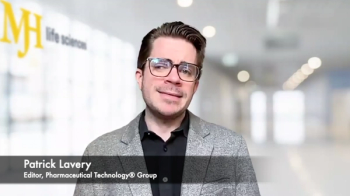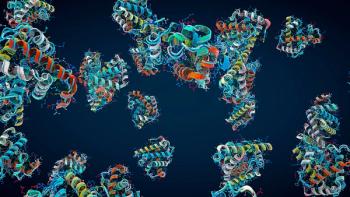
Commercial Production of Gene Therapies Using Suspension or Adherent Cell Lines
This article will explore the traditional path from the laboratory to the clinic and how the fixed-bed technology provides an alternative solution to meet commercial demands.
The gene therapy market is foreseen to reach over $3 billion and grow at a compound annual growth rate (CAGR) of 34% until 2023 (1, 2), which makes it one of the fastest growing fields of the biopharmaceutical market. Initially gene therapy owed its popularity to its ability to treat rare and previously uncurable diseases; however, these products are gaining traction in treating more common diseases such as cancers. The most common viral vectors used in gene therapy are based on adeno-associated virus (AAV) and lentivirus. However, adenovirus and retrovirus are also of interest in this space (the latter being primarily used in Chimeric antigen receptor T (CAR-T) cell therapy and not as a primary vehicle). and must be produced in cell culture. This is, most often done using transient transfection as a means of integrating the viral genome into the cells, although stable producer cells lines aredeveloped and used (3). Mammalians cells, especially HEK293, are popular hosts; however, insect cells are also used. These originate as tissue and thus favor growing in adherence but are also being adapted to grow in suspension.
The major driver for early-stage gene therapy developers is speed to clinic, where drug efficacy can be proven and used to raise further funding for industrialization. At the same time, the production platform selected to manufacture clinical material must be scalable in order to enable the target capacity to be reached and promote cost-effectiveness. Adherent cell lines are the most common choice at early stages of development as they are readily sourced, easy to cultivate at the laboratory scale, and require less expert bioengineering know-how.
As a gene therapy moves to the clinic and the scale of production is increased, developers may consider switching to a suspension cell line as these are perceived as offering the advantage of being scalable and readily industrializable using well known stirred tank bioreactors (STRs), as opposed to multi-tray culture systems. To reduce upfront expenses and to overcome limited manufacturing experience, developers will also often choose to work with a contract development and manufacturing organization (CDMO), who may contribute to the cell line choice as some offer proprietary systems. Another driver pushing developers to consider suspension cell lines is the desire to move away from serum for biosafety, cost, supply, and processing needs. However, as it will be explained later, the usage of suspension-adapted cells for industrial production presents several drawbacks. Recent technological developments have made available advanced fixed-bed bioreactors (FBRs) that allow the successful and cost-effective development and commercialization of gene therapies using adherent cell lines, which brings several advantages compared to using suspension-based systems.
Bioreactors designs
Historically, STRs were adapted from the chemical industry to fit the needs of first the brewing and then the biopharmaceutical industry in order to enable the affordable industrialization of biotherapeutics. STRs offer several advantages: they are scalable and the principles by which to do so are well known, they offer precise and reproducible control of the culture conditions, and they are highly automated. The rise of therapeutic monoclonal antibodies (mAbs) in the 1980s drove the requirement to adapt Chinese hamster ovary (CHO) cells to suspension in order to allow the use of stirred tank bioreactor for industrial production. Subsequent work lasting decades improved cell line robustness and increased product titres 100-fold (4), which drove the production costs down. Cells used for gene therapy have not gone through this lengthy adaptation, which means that current suspension-adapted cell lines for the production or viral vectors still suffer from drawbacks as they are less robust in industrial settings (i.e., presence of shear forces in stirred bioreactor, sensitivity to variations in their environment [pH DO, T, etc.]( 5, 6). They require the execution of transient transfection steps to introduce viral material into the cells (i.e., stable producers of viral vectors exist but suffer from several shortfalls (3, 5) . Scaling strategies in STRs are well established though, and single-use options exist from the millilitre scale up to 6000 L (7).
Recent technological innovations provide substitute solutions. The development of breakthrough FBRs bring new opportunities in readily developing and scaling adherent platforms as an alternative to STRs. FBRs provide a support matrix for cell adherence while allowing the same level of control as in stirred tank bioreactors, a straight-forward scaling strategy, and industrial throughput capacities. By comparison to STRs, FBRs are “segregated” systems where the cells, immobilized in the bed, are decoupled from the liquid medium and regulations, which allows for parameters to be optimized with less direct impact on the cells. Despite being a relatively recent technology, the fixed-bed technology has gained traction in the gene therapy field as it provides a rapid solution for industrialization, frequently limiting process development risks, robust scale-up strategies, and the ability to produce industrial quantities using single-use technologies. FBRs “trap” cells within a solid but permeable structure and circulates media through it, thereby ensuring adequate nutrient and oxygen distribution. The fixed-bed principle allows for cells to be grown to much higher densities per unit volume of vessel than they would be in a stirred tank bioreactor, which results in a much more compact equipment and lower footprint at equivalent throughput than an STR. Vessel volumes for fixed-bed bioreactors range from hundreds of millilitres to approximately 50 L for an equivalent throughput to an STR 1000 L and above.
Bioprocessing considerations
To promote cell growth, nutrients and oxygen supply must be homogeneous throughout the bioreactor. In suspension cultures, this is ensured by providing said nutrients in the culture medium (i.e., in batch, fed batch, or perfusion-mode), bringing oxygen via either overhead gas circulation in small scale bioreactors or sparging in large bioreactors, and by agitating to ensure the mix is homogeneous, the gas transfer (kLa) is sufficient, and that there are no gradients in temperature and pH. The environment that this creates can be detrimental to cell health if not controlled adequately. The mechanical shear forces from the impeller and the oxidative stresses caused by a large amount of dispersed bubbles can also be harmful to the cells. Mixing is more efficient at small scale than at large scale, which means that during development it is relatively easy to achieve satisfactory gas transfer at conditions that do not hamper cell growth.
When scaling-up, the ratio of the total vessel volume (m3) to the surface available for heat and gas transfer (m²) increases, which means that agitation and gas flow rate must be increased non-linearly to guarantee sufficient gas transfer (intake of O2 and stripping of CO2) and avoid risks of heterogeneities (in nutrients, pH, gases). As the cells are suspended in the liquid medium, they will be exposed to higher mechanical forces and risks of local oxidative stresses, which may lead to reduced growth and productivity.
In FBRs, nutrients and gasses are provided to the cells through circulation or perfusion of the medium through the fixed bed while the cells are immobilized. The cells are only in contact with the impeller during the seeding stage which means their exposure to high shear forces is limited. Viral material will, however, circulate freely throughout the vessel and care will need to be taken if the materials are shear sensitive. Using a structured fixed bed encourages homogeneous cell distribution and operation at lower agitation speeds results in lower shear exposure. FBRs vessel volumes are much smaller than equivalent STRs; therefore, the ratios of vessel volume to surface for gas and heat exchange do not change as much when scaling-up or down, making it easier to maintain homogeneous conditions inside the vessel.
Scale-up strategy
Scaling a cell culture process from the laboratory to commercial scale in a fast, risk-free, and cost-effective manner is the challenge faced by developers of novel gene therapies. The process steps and conditions established at small scale ideally must be linearly translatable to large scale without the need for extensive re-development, which would be costly and cause delays to product launch.
For suspension cells in STRs, the seed train is straightforward: an inoculum is prepared in a shake flask and gradually increased in volume to bioreactors, usually up to 10-fold at a time, until it reaches the seeding quantity required for the production scale vessel. In between, cells are harvested and used to seed the next scale of bioreactor. For adherent cells in FBRs, inoculum preparation will include growing cells initially in flatware and then in multi-tray dish(es). Cells are enzymatically detached to seed the FBR. Particular care must be taken to ensure cells are present as single units in order to promote even cell distribution throughout the bed, which is a paramount to ensure process predictability and reproducibility.
An advantage of FBRs is that because cells are in higher concentration than in STR at seeding due to the lower volume of the vessel, less are needed for inoculation, which reduces the operational burden of seed generation. For the cell expansion stage, it must be ensured that nutrients and gases are supplied in non-limiting conditions at scale, which often engenders shear and oxidative stresses if not carefully controlled in STRs as described earlier. Perfusion is a popular choice to sustain cell culture and reach high productivity but requires development. In STRs, an external cell retention device must be used, and these exist in low-shear options which will minimize cell stress. FBRs again possess an advantage here as cells are naturally retained by the bed thus eliminating the need for complex cell retention devices. This is both beneficial to the cells (less exposure to shear forces) but also the process complexity and costs.
Transfection developed at the laboratory scale is usually done in ideal conditions, where media can be removed and replaced by the transfection mix with optional washing steps. This is usually not easily carried out at scale in STRs as this would require handling hundreds to thousands of litres of liquid. Instead, either the cells are concentrated using filtration or the mix is added directly to the cell culture. Each suffers drawbacks: concentration is an extra step that takes time and needs to be developed, while adding a transfection mixture without prewashing steps and at a different final concentration than used in development will result in having to re-develop the process to ensure it is productive. Transfection mixes are also sensitive to pH changes, and therefore, any inhomogeneity in large tanks are a source of worry. In FBRs, the story is different: as long as the ratio of the vessel volume to the surface available for growth remains the same, the transfection process developed at small scale can be directly and linearly transferred to large scale, without needing to either concentrate, dilute, or re-develop the transfection mixture.
Conclusion
While suspension-based cell culture has successfully being used in scalable production of biologics resulting in high titres and low cost of goods, its application to gene therapy manufacture is hampered by inherent drawbacks in the basic mechanics and operational constraints of stirred tanks bioreactors and their consequential effects on productivity and process complexity. Emerging fixed-bed bioreactor technology allowing the cost-effective and industrial-scale use of adherent cell lines by enabling scalable, reproducible, and simplified processing (i.e., reduced seed train, effective transfection, and lower processing volume) will play an increasing role in ensuring that gene therapies can reach the market sufficient quantities and at affordable costs.
References
- Grand View Research, "Gene Therapy Market Size, Share & Trends Analysis," 2019.
- Markets and Markets, "Gene Therapy Market by Vectors," 2019.
- F. Masri, E. Cheeseman, and S. Ansorge, Cell & Gene Therapy Insights, 5 (S5) 949-970 (2019).
- O.-W. Merten, M. Schweizer, A. Kamen, and P. Chahal, Pharmaceutical Bioprocessing, (2014).
- R. Kunert and D. Reinhart , Appl Microbiol Biotechnol, 100 3451–3461 (2016).
- R. Gilbert, Cell & gene therapy insights, 6 (1) 143-148 (2020).
- V. Barba, "ABEC launches 6,000 L single-use bioreactor to answer scalability needs," BioPharma-Reporter.com, Sept.12, 2019.
About the Authors
Jean-Christophe Drugmand is senior bioprocess architect focusing on innovation and conceptual design and Alex Chatel is product manager for viral applications, both at Univercells Technologies.
Newsletter
Stay at the forefront of biopharmaceutical innovation—subscribe to BioPharm International for expert insights on drug development, manufacturing, compliance, and more.




